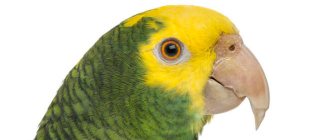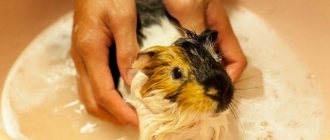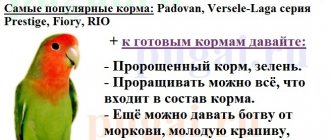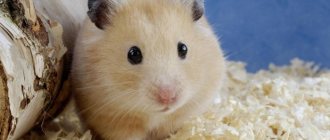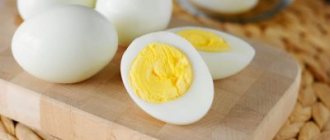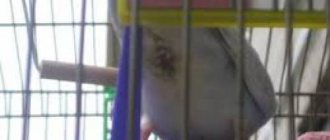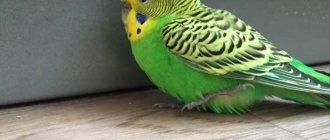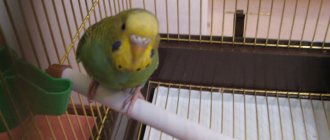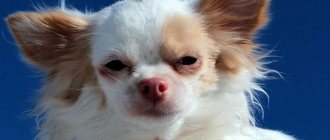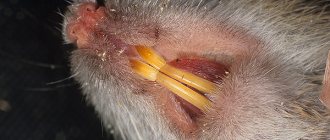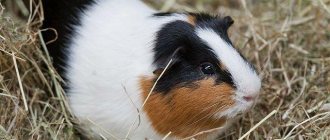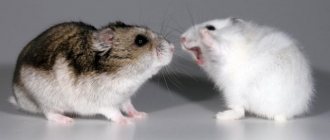Wavys are cute domestic birds that need constant care from the owner. The health, mood and life expectancy of the pet depend on the correctness of this process.
Therefore, sometimes you even have to trim the bird’s beak. It is important to understand the nuances of how to trim a budgie’s beak correctly and not harm your pet. Additionally, it is necessary to use certain preventive measures aimed at preventing the growth of the stratum corneum.
Is it necessary to trim the horny part?
The bird's beak consists of several parts, which include:
beak;- mandible;
- tendon ligament;
- the cere on which the nostrils are located.
The beak is not fused with the skull, which ensures its mobility. The bone is covered on top with a special horny layer, which grows throughout the bird’s life.
Wavys constantly use their beak, which leads to abrasion on the sides. The abraded stratum corneum constantly grows, so under normal conditions it is completely replaced within 6 months.
In any case, the owner needs to monitor the condition of the beak . If necessary, the excess horny part is cut off.
The beak is a significant organ for a parrot, since with its help the bird cleans feathers, grabs food and other objects, builds a nest, feeds chicks, protects itself from other birds and gets rid of pests.
If the bird was unable to grind off the horny part on its own, then it begins to have difficulty performing normal actions. Difficulties may arise even with independent feeding.
This leads to decreased activity and deterioration of plumage. If the bird cannot eat at all, it will get sick and die from exhaustion. Sometimes wavy birds actually injure themselves while cleaning their feathers.
It’s also useful to read: Why does a parrot’s beak peel off?
The role of the beak for a parrot
The beak only in appearance seems hard, stone, lifeless. This is a sensitive organ of touch; it helps the bird to sense heat and cold, touch, and the shape of objects. Also, with the help of its beak, the budgie performs the necessary actions:
- crushes and grabs food;
- cracks nut shells;
- cleans and smoothes feathers;
- combs out parasites;
- builds a nest (loop);
- carries objects;
- climbs trees or cage bars;
- turns eggs;
- feeds the chicks.
The beak is needed not only to ensure the life of the parrot. It has another important purpose: this attribute of appearance serves to intimidate opponents. Defending territory, the bird screams furiously, bites and plucks feathers from its opponent.
Reasons for the growth
If the owner of a wavy bird notices that even with regular trimming, the beak is growing too quickly, then the cause of the problem must be determined.
This is usually due to the following reasons:
- Poor nutrition . In addition to standard grain mixtures and soft fruits, the bird's diet includes solid foods such as nuts or cereals. Among fruits, preference is given to firm apples and pears.
- Hormonal imbalances . They occur during frequent egg laying or stressful situations. Therefore, it is necessary to provide a calm and quiet environment for the bird.
- Liver problems . They can only be identified during an examination by a veterinarian, who can take tests and identify diseases.
- Frequent trimming. Some owners get too carried away, so they start trimming the beak literally every other day. This leads to rapid growth of the stratum corneum.
- Lack of means for grinding. Sometimes a parrot simply does not have the ability to sharpen its beak on its own. Therefore, the owner must ensure that the cage contains twigs or tree bark. You can buy special chalk or other ready-made poultry products.
- Lack of vitamins or minerals . To eliminate the problem, you can buy special vitamin supplements to restore elements.
If you identify the cause of beak enlargement, you can quickly correct the problem and improve your pet’s condition.
It’s also useful to read: Growth on a parrot’s beak
When should a person intervene?
Budgerigars are born fashionistas. Not a day goes by that they don't take care of their appearance. The main tool for hygienic care in birds is the beak. Therefore, its regrowth beyond measure inevitably leads to injury to the delicate skin of pets.
Additional "arm" and "leg"
The wavy beak is a universal assistant. He allows the parrot:
- capture, crush and grind food;
- get rid of parasites;
- scan the temperature and shape of objects;
- provide belay while climbing;
- carry objects;
- build a nest and feed the offspring;
- protect yourself from predators;
- communicate with people or relatives.
If a bird's beak is too large, many important manipulations will be inaccessible to it. This is exactly the moment when the owner’s intervention is simply necessary.
Reasons for regrowth
In most cases, the impetus for a change in the shape and size of a parrot's beak is trauma. Hitting the bars in a cramped cage, colliding with furniture and knocking on glass is not as harmless as it may seem to an inexperienced breeder. At the site of the bird's bruise, horny tissue begins to grow. Because of this, the shape of the beak changes and it quickly increases in size.
Quite often, the cause of rapid regrowth of a pet’s bone organ is an imbalance in the diet. A lack of vitamins or minerals, an excess of fatty feeds and a predominance of soft formulations over hard ones lead to a significant increase in the bird's beak.
There are times when a parrot's beak has to be trimmed due to parasitic infestations and fungal infections. If you suspect an aggressive nature of the problem, you should first have your pet checked by a veterinarian. Most often, parrots are found to have scabies mites. These parasites settle inside the tissues of the cornea and limbs of birds. This leads to the formation of dense growths. In this case, the problem cannot be solved without the help of a doctor.
Birds kept at home do not always have the opportunity to grind their ever-growing beaks on hard and rough surfaces. This is overlooked by many wavy owners. As a result, the stratum corneum of the parrot's beak wears off more slowly than in the wild. At the same time, the natural rate of tissue growth is maintained. This helps to increase the length of the parrot's bony organ.
Important! Do not clear the bark from the perches inside your pet's cage. The rough surface helps the wavy birds to grind off their growing beaks in a timely manner.
In rare cases, the causes of accelerated growth of bone tissue in parrots are hormonal disorders (most often in older males) or genetic abnormalities and diseases of internal organs.
What does a “problem” pet look like?
Changing the shape and size of the beak creates many problems for the bird. This always affects the condition of the pet. A parrot with an overgrown beak changes dramatically in behavior and appearance. He becomes a little slower, sits on the perch more often and flies and chirps less.
The pet's appearance changes for the worse. The feathers fade and often begin to fall out or become puffy on the neck.
Many breeders note that a parrot with an overgrown “horn” has a worsening appetite. The deformed bone shell causes pain to the bird, and the wavy pet is unusually cautious when grabbing pieces of food.
Interesting! An excess of calcium in the diet is harmful for parrots, as it always leads to accelerated growth of bone tissue. First of all, this concerns the beak. You can tell that there is too much calcium by the whitish color of the excrement of winged pets.
How to properly trim the horny part at home
The procedure is carried out carefully, since if done incorrectly, irreparable harm can be caused to the wavy. It is advisable to involve a second person in the process, since one will hold the bird, and the second will perform the necessary manipulations to trim off the excess part of the beak.
If the owner has experience, he can do the pruning himself.
Required Tools
To trim the horny part of the beak, the following equipment is prepared:
- a special tool that is sold in pet stores, and in appearance it looks like nail scissors;
- a small piece of cotton wool;
- alcohol or other antiseptic;
- hydrogen peroxide, which is useful if the integrity of the blood vessel is compromised.
The beak contains blood vessels, so it is important to trim in such a way as not to damage them. But the bird may jerk at the wrong moment, causing damage to living tissue. This causes bleeding, which can be stopped with peroxide. To avoid damaging the vessel, it is recommended to illuminate the beak with a flashlight before creating a cut.
Has your parrot been sick?
Not really
The process of cutting off excess parts
To cut off the tip of the beak, the following steps are performed:
- instruments are treated with alcohol or other disinfectant;
- work is performed in good lighting;
- the bird is fixed in the hand, for which the wings are pressed against the body, but you cannot press too hard;
- the beak is illuminated with a flashlight to determine where the blood vessels end;
- You can mark it with a pencil so you know where to make the cut;
- it is impossible to cut off the stratum corneum in one movement, so it is advisable to make small sections;
- the procedure is carried out until the beak takes on a suitable shape;
- at the end of the process, treatment is carried out with a weak solution of potassium permanganate or hydrogen peroxide.
After the procedure, the bird is transplanted into a cage, and the wavy birds often experience stress, so they need to be left alone for a while . It is important to give your pet clean water, but remove the food for about 4 hours. This is necessary so that germs and contaminants do not get into the small cracks and frames that form during trimming of the stratum corneum.
It is recommended to treat tools used during the process with alcohol.
Possible problems
Difficulties may arise when cutting off excess parts:
- you cannot cut off too much of a part, as this can lead to the appearance of significant cracks, and the beak may burst, so harmful bacteria can easily penetrate into the crack;
- if you use rough instruments, such as nippers or forceps, as this often leads to excessive cutting of the stratum corneum, so the bird will bleed;
- if living tissue is touched and blood appears, then it is necessary to pour hydrogen peroxide onto a cotton swab, which is then applied to the wound.
If the procedure is performed by a beginner, then it is advisable to cut off the beak in small parts. Although the process takes a lot of time, it helps to obtain the desired result.
Prevention of overgrowth
To prevent excessive growth of the horny part, it is recommended to use certain preventive measures.
These include:
- toys and objects are placed in the cage, with the help of which the wavy can easily grind off the excess parts on the beak, for which only wooden elements are selected;
- it is important to regularly buy your pet a mineral stone, which not only acts as a source of microelements, but also allows the bird to sharpen its beak;
- The diet includes solid foods such as grains and seeds.
Vitamins are useful products for any bird, but there is no need to overdo it with them, so the dosages indicated on the package are taken into account.
Parasites
There are cases when growths appear on the beak due to the presence of parasites on the bird. If observed:
- nose enlargement;
- growths similar to papillomas around the eyes, on the wax, paws,
then these are symptoms that parasitic microorganisms have settled on the pet. To get rid of them, you need to treat areas with growths with aversectin or novertin ointments.
